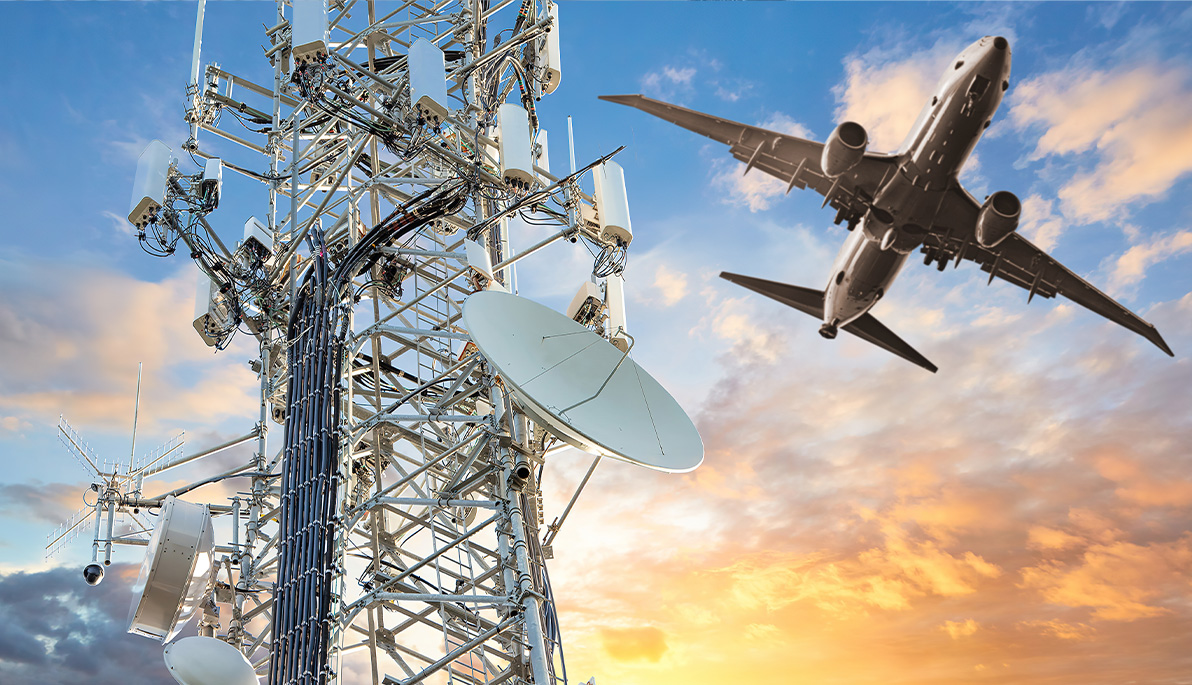News
The Trouble With 5G
January 24, 2022
Airlines and the Federal Aviation Administration (FAA) have been concerned about the 5G rollout and how it can interfere with flight navigation. In a Q&A with The Box, Batu Chalise, Ph.D., assistant professor of electrical and computer engineering, explains how the new network interferes with flight navigation and what can be done to keep air travel safe.
What is the current situation regarding the 5G rollout near certain U.S. airports? Why is this controversial?
New 5G network rollout in the United States will use C-band radio frequency (RF) of 3.7 to 3.98 GHz. Radar altimeters are used to measure the height of an aircraft above ground and provide important safety and navigation information operating at 4.2 to 4.4 GHz. Since the two systems operate at nearby frequencies, high-powered 5G base station antennas can interfere with aircraft radar altimeters, hampering the safety of air flights. This issue has been raised by the FAA and ICAO (International Civil Aviation Organization). They want 5G network operators to halt their services (at least near airports) before deploying additional measures that can guarantee that aircraft communications are not affected by 5G signals.
How does the much-heralded and improved 5G phone network potentially interfere with aircraft radars?
The much-heralded and improved 5G systems are providing very reliable data rate transmissions at low latency, supporting several heterogeneous wireless networks. The 5G rollout will still operate in the sub-6-GHz frequency range, though it is now very congested because a vast majority of current wireless applications operate in this frequency range, including aircraft radars. There is an option for 5G operators to move their operations to higher frequency ranges, e.g., above 6 GHz, to avoid interference to radar altimeters and provide further improved communications services, but the required technologies that support high-frequency ranges are not mature enough for immediate network deployment. Any change in the operating radio frequencies may also require changes in 5G smartphones. There are already millions of 5G smartphones in the market.
Approximately 40 countries have been able to deploy 5G technology near airports without disrupting aviation, so why is the United States experiencing this issue?
5G network rollout in different countries is occurring in different ways. For example, in Asia, 5G networks use lower frequencies (3.3 to 3.8 GHz), which means that interference from 5G networks to aircraft radars (radar altimeters) is not harmful. The United States is experiencing this controversy since the 5G rollout is in the frequency band that is closer to the operating frequency of radio altimeters, as noted earlier.
Large wireless carriers have agreed to delay 5G rollout near select airports for the next six months. What will be addressed during this time to ensure safety once the rollout is completed?
A temporary solution is to limit 5G services within the buffer zones around airports in the United States. The network providers can set up their 5G masts to transmit low powers around these buffer zones. As a permanent solution, 5G operators may need to improve their technologies and ensure that interference caused to radio altimeters is in the acceptable range, or the FAA should look for alternative options. For example, shifting aircraft communications operations to other frequency bands and using GPS to replace existing communications around airports. Before doing so, it may be necessary to conduct further extensive field tests to correctly quantify the interference from 5G signals to airport radars so that the larger scientific community agrees upon such interference problems, as well as potential solutions.
Ultimately, where does the responsibility lie (e.g., is this a wireless carrier issue, an airline manufacturer issue, or an issue with antennas)? How and when will it be resolved?
Quick deployment of 5G communications is very important for our economic growth. On the other hand, the safety of air travel cannot be compromised. The concerned communities may need to work together to find a common solution that is beneficial for all parties. However, in my opinion, the major responsibility lies with the Federal Communications Commission, which licenses and regulates the available RF frequency spectrum.
This interview has been edited. Babak D. Beheshti, Ph.D., dean of the College of Engineering and Computing Sciences, contributed to this article.




